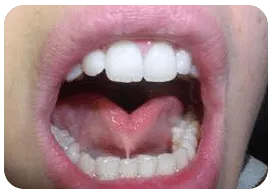TONGUE TIE
OMT & Mouth Breathing
Proper tongue posture supports a healthy airway by promoting nasal breathing. Nasal breathing is important and beneficial for our overall health in several ways. It warms, moistens, and filters the air we breathe and allows for a more restorative, restful sleep.
Nitric oxide is produced in the sinuses and is important for our cardiovascular system. It increases physical endurance and stamina, helps to carry, and provide 18% more oxygen to our brain and muscles, it balances pH in the blood, decreases cortisol levels and increases melatonin. Nasal breathing allows you to breathe through your diaphragm which activates the “rest and digest” response in our bodies. Rest, digest, and repair during sleep is vitally important for our overall health. Kids produce the growth hormone when they are in the deep rem sleep and its essential for proper growth.

A tongue tie is a term used to describe a restriction of the lingual frenum. A lingual frenum is the band of tissue under the tongue that holds the tongue to the floor of the mouth. Depending on where the frenum attaches to the tongue, it may cause mild to severe restriction to the mobility and function of the tongue.
The tongue is a dominating muscle for the body regarding posture, airway, and facial development. It is made up of eight different muscles and attaches to key areas in the head and neck region that can be affected negatively. The tongue muscles serve to elevate, protrude, and retract, and it controls the tongue position, tongue tip and tongue shape.
It is a major key in the beginning stages of digestion while directing the food around the mouth
Just as with any other muscle in the body, when you have a strain or a sprain, other muscles surrounding that area can be affected. If a tongue restriction is present, it’s not just restraining the tongue. It’s restraining every muscle attached to the tongue, and every muscle those muscles are attached to.
- Clenching and grinding
- Chronic headaches/ migraines
- Jaw pain
- Neck, shoulder, back pain, or tension
- Forward head posture
- Ortho problems and relapse
- GI issues (bloating, burping, acid reflux)


Consequently, when the accessory muscles compensate for the lack of proper tongue function, it can cause symptoms that affect your lifestyle, your health, and your oral biome.
Symptoms in children can demonstrate as:


- Gagging, choking
- Picky, noisy, or messy eaters
- Open mouth chewing
- Delayed development of speech
- Ear infections
- Teeth grinding
- Snoring/ SDB
- Increased risk of caries


Tied 2 Myo
This program is specifically designed for more comprehensive cases. Clients that require a frenectomy, lip or tongue tie release, will require specific pre and post frenectomy exercises and wound care. Additionally, when restrictions are present it is common for severe muscle compensation to accompany someone with a tethered oral tissue to make up for the lack of proper mobility and function from the tongue.


If there is a tongue tie observed at the initial assessment, you may require a simple procedure called a frenectomy, which will release the restricted frenum. Orofacial myofunctional therapy (OMT) will help with the pre and post frenectomy procedure to prepare the muscles for the procedure, to train the tongue to develop better oral muscle patterns, and to teach the tongue proper function following the procedure, as it has not been properly used before.
Therapy helps to achieve balance by focusing on the four goals of Myofunctional therapy for improved breathing, eating, swallowing, posture, quality of sleep and overall health.
FAQ'S




Our priority is to build rapport with our clients by taking the time to get to know them and listen to their concerns and goals. We genuinely want to elevate our clients to their personal best in aspects of their oral health to achieve optimal health.
Our intention is to alleviate anxiety by providing a comfortable, relaxing setting that brings serenity and calmness to a spa-like experience. We use the newest technology with EMS-guided biofilm therapy, which is minimally invasive, effective, and gentle on the teeth and soft tissues with a heating system with an adjustable water temperature for client comfort.


